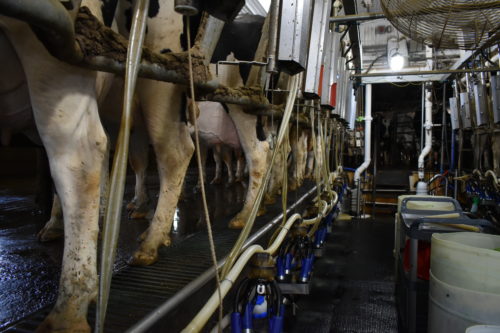The Most Common Reasons Cows Get Mastitis
Posted: October 29, 2020 | Written By: Mario Solis Flores

Contracting mastitis in fresh dairy cows is a complicated process that requires a close look at the conditions and situations that allow for this harmful disease to develop. Mastitis is defined as an inflammation of the mammary gland caused by bacteria introduced either during the milking process or from environmental contact. The cow has three mechanisms of defense against mastitis. The first mechanism of defense is the keratin plug that forms in the teat canal one hour after the cow is milked. The purpose of the keratin plug is to prevent bacteria from entering the udder. The second mechanism of defense are the white blood cells inside the udder. When mastitis-causing bacteria invade the udder, harmful bacteria begin to multiply. These harmful bacteria release toxins and cause white cells to release bioactive chemicals that trigger the cow’s immune system. When bacteria create more damage to the udder tissue and white blood cells can’t fight the infection, and there is more damage to the cells producing milk, the third mechanism of defense destroys the milk producing tissue.
In a healthy cow, when infection is detected, the cow increases blood flow to infected tissue sending white blood cells to counterattack the infection. The white blood cells have two purposes: destroy harmful bacteria residing in the infection and engulf and ingest damaged and dying bacteria cells.
As the infection continues internal swelling in the udder occurs, milk-producing cells begin to break down. Severe damage will cause permanent loss of milk. As the cow responds to infection changes in the udder including redness, swelling and significant pain will be detected. The composition of the milk will include changes such as increased pH, raised water content, and the presence of visible clots and flakes. In severe cases the cow will look sick, have a fever, dehydration and refuse to eat.
Some of the most common ways to introduce harmful bacteria into the udder and create mastitis are:
Milking dirty cows
Manure provides the perfect environment for many types of bacteria, residing in many surfaces in a dairy facility. The build-up of organic matter on cow’s teats decrease the ability for milking units to attach to clean teats. Most mastitis infections are initiated during the milk harvesting process. It is very critical to have a well-established wiping technique during milking to avoid introducing harmful bacteria into the udder. The more organic matter on the cows, the harder it is to keep milking units clean of manure.
Cross-contamination
It is always a good practice to backflush units with a disinfectant solution after identifying a clinical case of mastitis. Many types of bacteria are opportunist, contaminating the next cows in line. Another form of cross-contaminate occurs by utilizing wet towels or using dirty towels with multiple cows.
Air slips
Air slips can inject bacteria from the milking cluster or inflations into the udder. Avoiding air slips through enough stimulation will help eliminate this issue. This is accomplished when becomes sealed to the walls of the inflation during milking. Correct unit placement and using hose holders can reduce the amount of air slippage.
Post dip coverage
Post dip coverage will prevent bacteria from attaching to the teat, following unit removal, as long as more than ¾ of the teat is covered with dip. Dip also will help to maintain proper skin condition. The cow protects herself from pathogens by utilizing natural oils which condition the skin surface of the teats. Dip coverage will be the only protection the cow has while the keratin plug forms to seal the teat canal. Make sure all dip cups and dip utensils are cleaned during and after milk harvest to prevent dip contamination by manure or organic matter.
Milking equipment
Preventive maintenance programs on milking equipment such as fall-off tests, pulsator maintenance, regular replacement of rubber parts, and verifying vacuum level will help prevent any type of vacuum fluctuations, teat irritation and teat damage, and will reduce the risk of pathogens from entering the udder.